 |
February 2017
|
February 2017 // Volume 55 // Number 1 // Feature // v55-1a4
Assessing Public Issues Knowledge and Needs of Extension Agents in Florida
Abstract
It has been argued that to remain relevant in today's society, Extension must expand its role to provide public issues education. We conducted a web-based survey to determine whether Extension agents in Florida were prepared to deal with contentious issues. Survey respondents identified issues affecting their clientele, levels of frequency with which they addressed the issues, and self-perceived levels of knowledge related to the issues. Results were analyzed by agent type (i.e., programmatic area). Results revealed that the issues of immigration, crop diseases, and food security held particular potential for improvement.
Introduction
Aptly described as bridging the scientific and practical worlds, Extension agents have the capacity to effect positive changes in their communities through problem solving and dissemination of information from universities to the general populace (Hamilton, Chen, Pillemer, & Meador, 2013; Harder, Israel, & Lamm, 2011; Rasmussen, 1989; Rogers, 2003). Historically Extension has been successful in its mission, but today various barriers challenge Extension agents. These barriers include managing resources in the face of shrinking budgets, serving an ever widening clientele base with great variation in background and prior knowledge, making use of a growing number of technological advancements, and dealing with highly contentious public issues (Ladewig & Rohs, 2000; Raison, 2014; Scheer, Harder, & Place, 2011). Peek et al. (2015) and Huang and Lamm (2015) have argued that for Extension to remain relevant and garner political support in today's environment, it must expand its role to include public issues education.
A public issue can be defined as a topic involving widespread impact or concern (Dale & Hahn, 1994; Patton & Blaine, 2001). Most issues originate as private issues and become public when outside agencies become involved and widespread support or opposition is gained. Many public issues relate to an identifiable problem, whereas others may arise from misinformation or inaccurate perceptions (Patton & Blaine, 2001). Issues arising from a clear source with clear or recognizable solutions result in simple resolution; on the other hand, those having an unidentifiable basis or unknown or disagreeable solutions may prove more problematic (Patton & Blaine, 2001). These contentious issues often create situations in which public input and education can be keys to solving the problem; however, due to the highly charged nature of such issues, many leaders tend to avoid them (Jolley, 2007; Patton & Blaine, 2001; Rittel & Webber, 1973).
Due to changes in the technological and economic environments, the number of farms has decreased in the last 100 years (Sharp, Imerman, & Peters, 2002). The shift away from rural life has generated a gap in public knowledge regarding agriculture and natural resources (Braier, Collins, Kelsey, Lenihan, & Whitmer, 2006; Doerfert, 2011). This knowledge gap means that current policies are based on the opinions of a population that possesses very little knowledge of agriculture and natural resources (Frick, Birkenholz, & Machtmes, 1995). Due to this lack of direct knowledge, a number of public issues have arisen in the agriculture and natural resources arenas, including controversial agricultural practices, cultural conflicts, environmental impacts, food safety, obesity, and water quality and quantity (Grudens-Schuck, 2003). For Extension agents to fulfill their mission as change agents and purveyors of agriculture and natural resources information, they must stay well informed on relevant public issues (Harder, Lamm, & Strong, 2009). An important question, then, is this: Are there deficiencies in Extension agents' knowledge about public issues that need to be addressed?
Needs assessments are widely accepted as valuable tools for identifying unmet needs (Caravella, 2006; Harder et al., 2009). Moreover, assessments should be used as a basis for designing and implementing strategies to fill unmet needs (Israel & Ilvento, 1995). Previous national and statewide needs assessments have shown that addressing public issues is a high priority for Extension and have identified the need for curricula that help Extension agents acquire or strengthen skills in public issues education (Huang & Lamm, 2015; Peek et al., 2015; Singletary et al., 2007). Because Extension agents, regardless of area of expertise, may be faced with any number of issues-related questions, it is important that areas of knowledge deficiency be quickly identified and addressed.
Purpose and Objectives
The purpose of our study was to determine the needs of Extension agents related to addressing public issues in agriculture and natural resources. The research was guided by the following objectives:
- Identify the public issues that Extension agents of different types (i.e., from different programmatic areas) say affect their clientele and the frequencies with which the agents address those issues.
- Determine whether Extension agents of different types require additional knowledge to provide education on the issues affecting their clientele.
Methods
The population for our study was Florida Extension agents (N = 350). Small population size and universal access to the Internet allowed for a census to be obtained via a web-based survey. The questions addressed in the study were part of a larger questionnaire designed to assess the needs of Florida Extension agents with regard to communicating about contentious issues and policies in agriculture and natural resources. Questions were researcher-developed and were based on results from qualitative interviews conducted with Florida Extension agents in November 2013. In those interviews, agents identified various issues they commonly faced with their clientele. Their responses were then categorized into the nine issues addressed in the study reported here: crop diseases, food safety, food security, immigration, management of endangered species, management of invasive species, urban/rural interface, water quality, and water quantity.
To identify the public issues affecting the agents' clientele, we presented survey respondents with the list of nine issues and asked that they select all applicable options. We assessed the frequencies with which respondents addressed the issues by using a 5-point Likert-type scale having the response options 1 = never, 2 = less than once a month, 3 = once a month, 4 = two to three times a month, and 5 = more than three times a month. We measured respondents' knowledge levels on the issues by using a 5-point Likert-type scale having the response options 1 = no knowledge, 2 = a little knowledge, 3 = some knowledge, 4 = moderate knowledge, and 5 = a lot of knowledge. Respondents were also asked demographic questions addressing sex, age, programmatic area, and years in Extension.
A panel of experts reviewed the final instrument to ensure reliability and face and content validity, and institutional review board approval was obtained from the University of Florida. The panel of experts included the associate director of the University of Florida Institute of Food and Agricultural Sciences Center for Public Issues Education, an assistant professor and Extension specialist, and the dean of Extension. These individuals were selected because of their content and survey construction knowledge.
Procedures followed Dillman, Smyth, and Christian's (2009) tailored design method. Five days prior to the launch of the study, a letter was emailed from the dean of Extension to all Extension agents in the state. First contact for the survey itself was made in mid June, and four reminders were sent. The survey closed 24 hr after the final notice was sent. Responses were received from 125 Extension agents, for a response rate of 35.7%. Nonresponse can be a threat to external validity. To account for nonresponse bias, respondents were compared to the target population, relative to known demographics: programmatic area and years in Extension (Miller & Smith, 1983). We found that respondents' characteristics for these demographics matched those of the target population; however, it is important to note that a limitation of the study is that the Extension agents who responded to the survey were more likely than their nonrespondent counterparts to feel that public issues affected them. Respondents were grouped by seven agent types: agriculture (AG), natural resources (NR), 4-H youth development (4-H), family and consumer sciences (FCS), horticulture (HORT), sea-grant (SEA), and agents of unspecified type (UN). Data were analyzed for frequencies using SPSS 21.0. Respondent demographics are displayed in Table 1.
| Characteristic | No. | % |
Known population demographics (%) |
| Sex | |||
| Female | 50 | 42.4 | |
| Male | 68 | 57.6 | |
| Age | |||
| 20–29 | 12 | 10.0 | |
| 30–39 | 22 | 18.3 | |
| 40–49 | 19 | 15.8 | |
| 50–59 | 48 | 40.0 | |
| 60–69 | 19 | 15.8 | |
| Programmatic area | |||
| Agriculture | 37 | 29.6 | 19.5 |
| Natural resources | 5 | 4.0 | 3.4 |
| 4-H youth development | 15 | 12.0 | 21.2 |
| Family and consumer sciences | 16 | 12.8 | 24.1 |
| Horticulture | 39 | 31.2 | 26.1 |
| Sea-grant | 6 | 4.8 | 4.3 |
| Unspecified | 7 | 5.6 | 2.0 |
| Years in Extension | |||
| 1–5 | 33 | 27.7 | 32.7 |
| 6–10 | 22 | 18.5 | 25.3 |
| 11–15 | 19 | 16.0 | 14.6 |
| 16–20 | 17 | 14.3 | 9.3 |
| 21–25 | 9 | 7.6 | 5.5 |
| 26+ | 19 | 16.0 | 12.2 |
| Note. n = 125. Some participants did not answer every question; completed questions from incomplete surveys were accepted for data analysis. | |||
Results
For most program areas, at least 50% of the agents identified four or more of the nine issues as issues affecting their clientele. As would be expected, different types of agents characterized different public issues as affecting their clientele. We summarized the frequencies with which agents in each program area addressed each issue by identifying the percentage of agents who reported addressing the issue at least once a month. We summarized the levels of knowledge reported by agents in each program area for each issue by identifying the percentage of agents who reported having at least some knowledge of the issue. Figures 1–6 (at the end of this section) show the relevant data for the two study objectives.
At least 50% of respondents in most program areas reported having at least some knowledge of the four issues most commonly identified as affecting their clientele. 4-H agents' knowledge of crop diseases and FCS agents' knowledge of urban/rural interface were the exceptions. Regarding issues affecting their clientele, 4-H agents identified crop diseases third most often, yet only 46% of the agents indicated having at least some knowledge of the issue. Similarly, FCS agents identified urban/rural interface third most often, yet only 46% of the agents indicated having at least some knowledge of the issue.
In most cases, the frequencies with which agents addressed an issue were relative to the proportion of agents who identified the issue as one affecting clients. An important exception related to HORT agents addressing the issue of crop diseases. Only 51% of HORT agents identified crop diseases as an issue affecting their clientele; however, 74% reported addressing this issue at least once a month.
Other notable findings related to immigration and food security. Immigration was infrequently addressed by all agent types. Of all agent types, AG agents most often reported that the issue affected their clientele and that they had at least some knowledge of the issue; however, only 10% of AG agents reported addressing the issue at least once a month. Food security was rarely reported as an issue affecting clientele. Although 69% of FCS agents reported that the issue affected their clientele and 50% reported addressing the issue at least once a month, these percentages were much lower for other types of agents.
Figure 1.
Agriculture Agent Issues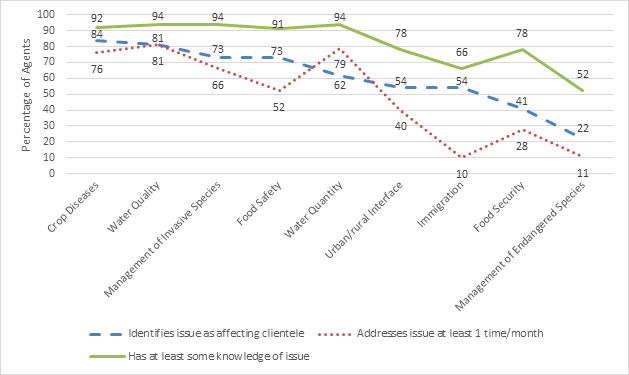
Figure 2.
Natural Resources Agent Issues
Figure 3.
4-H Agent Issues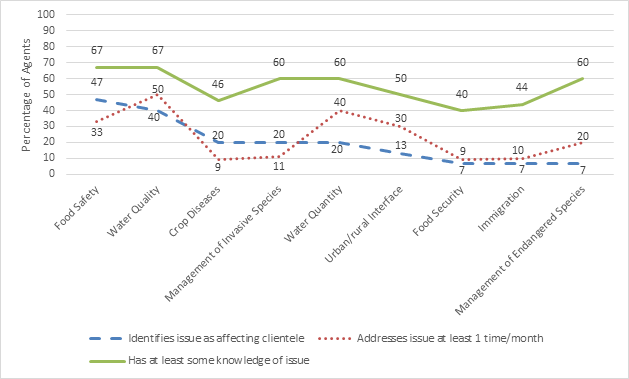
Figure 4.
Family and Consumer Science Agent Issues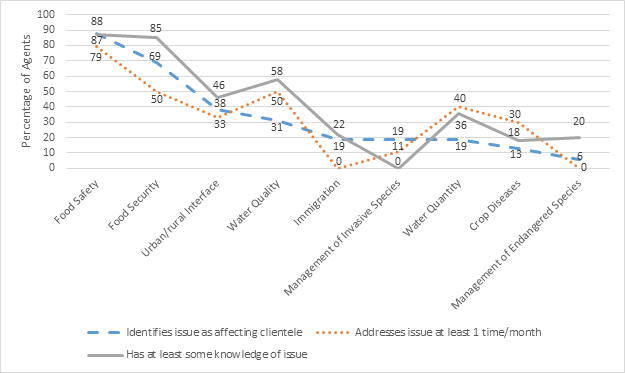
Figure 5.
Horticulture Agent Issues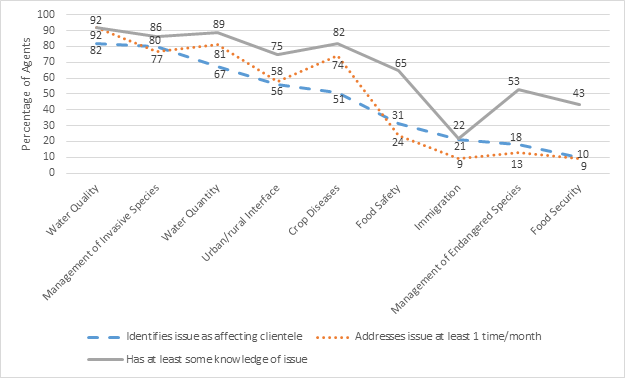
Figure 6.
Sea-Grant Agent Issues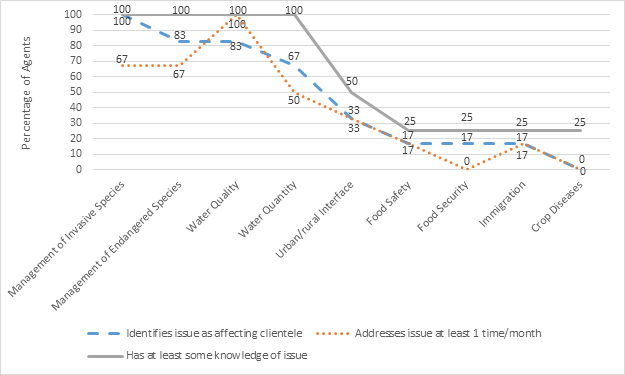
Conclusions, Implications, and Recommendations
Conclusions and implications from this research focus around two major concepts: (a) opportunities for Extension to become more involved with the issues of immigration and food security and (b) opportunities to better prepare agents to handle the issues of crop diseases and urban/rural interface. Herein, we discuss these opportunities and provide recommendations for addressing them through education and collaboration. We also make recommendations for future research based on the results and conclusions of our study.
Opportunities for Increased Involvement
The study findings indicate that Extension may not be as engaged with certain public issues as it could be. Remedying this situation may involve providing targeted training to certain Extension personnel, addressing new audiences, and developing innovative collaborations.
Immigration was an infrequently addressed topic for the vast majority of the Extension agents, with AG agents being most involved with the issue. Yet according to the most recent U.S. Census (U.S. Census Bureau, 2010), Florida's foreign-born immigrant population (19.7%) is significantly higher than the U.S. average (12.9%). Routinely, immigration occupies a substantial position within the news and political arenas in the state. On the basis of the large immigrant population and the public importance of the issue, the low frequency of 4-H and FCS involvement in immigration issues deserves examination. Additionally, relatively low immigration knowledge levels existed across all program areas, with AG as the only program area for which more than 45% of agents reported having at least some knowledge of the issue.
Providing Extension agents with training on immigration would fill a knowledge gap that could allow Extension to broaden its impact regarding this public issue. Traditionally minority populations, such as immigrants, have been underserved by Extension (Alston & Crutchfield, 2009). This deficiency in coverage presents Extension with a valuable opportunity to expand its clientele base and become more effective change agents with regard to this public issue. Developing programs targeting immigrants and working with the general public to communicate about this issue can help Extension play a greater role in public issues education. Increasing agents' knowledge of public issues propels Extension closer to the vision of Boyle and Mulcahy (1993), in which Extension fulfills a significant role in public education. Through collaboration with agricultural educators and outside organizations, Extension can make an even bigger impact. Classroom educators could play a large role in the public issue conversation by making a concerted effort to integrate immigrant populations at the high school level through the National FFA Organization and local agriculture programs. By combining efforts in formal and nonformal education, educators can work toward ensuring that immigrant populations are engaged in agriculture and that the general public is well educated on immigration issues.
Another area of interest worthy of discussion is food security. Although Extension agents reported having reasonable levels of knowledge about food security, the frequencies with which Extension agents address the topic are somewhat low. Opportunities may exist for Extension to proactively enhance its work in this area. For instance, efforts to help set up community gardens and other food-related venues could increase food security in food deserts. Extension agents also could cooperate with agricultural education professionals on high school programs that would bolster food security in an area through teaching people to grow their own fruits and vegetables. In fact, some high school agricultural programs are large enough to affect an area's food supply by producing food at a reduced cost and with increased security.
Opportunities for Better Preparation
Our findings identified areas in which Extension agents, regardless of specialization, could benefit from additional training related to public issues education that would allow them to better serve their clientele. In most cases, Extension agents possessed at least some knowledge of the issues affecting their clientele. However, the results of the study indicate needs in several areas. Proper training and resources are a necessity for ensuring that Extension agents of all types are prepared to assess issues and provide information and support to their clientele (Harder et al., 2011; Rogers, 2003).
Due to the extensive nature of crop diseases in Florida, it is not surprising that 74% of HORT agents addressed the issue of crop diseases at least once a month. However, an unexpected disparity existed between the frequency with which agents addressed the issue and the percentage of HORT agents identifying the issue as one affecting their clientele (51%). Another unexpected result in the HORT category related to levels of knowledge of crop diseases. Although 82% of HORT agents reported having at least some knowledge of crop diseases, this percentage could be considered lower than expected as the majority of HORT agents are hired on the basis of their expertise in the field. Providing HORT agents with up-to-date resources and cutting-edge in-service trainings could be key to making sure they recognize the extent of the issue of crop diseases and are prepared with adequate knowledge to educate clientele on them.
Overall, Extension agents reported having at least some knowledge of the issues they addressed most frequently. At least 50% of most agent types reported having at least some knowledge of the four issues most frequently identified as those affecting their clientele. However, for the 4-H program area, less than half of the agents reported having at least some knowledge of crop diseases, the issue identified third most often as one affecting the group's clientele. Similarly, less than half of FCS agents reported having at least some knowledge of urban/rural interface, even though this issue was identified third most often as one affecting the agents' clientele. Opportunities exist to support these agents by providing them with additional education that will assist them in addressing these issues of relevance to their clientele. In addition, it might be beneficial to help these agents partner with those in other fields of expertise to address these client issues.
Additional Opportunities
Related to the bigger picture, Extension should focus on creating a public issues education task force that would include state specialists and county Extension agents. Extension agents serving on this task force could address varied public issues concerns communicated by Extension clientele. Task force teams could better address political and social issues related to the state on a broader platform.
With additional studies, researchers should attempt to identify public issues facing other regions of the United States to determine the effects of such issues in those areas. A national study examining public issues could help guide a coalition movement through Extension aimed at addressing public issues and helping Extension become more relevant. Furthermore, an in-depth study of how these issues are affecting Extension clientele and the types of programs already in place to deal with them could provide great benefit to Extension. Future studies should involve a more extensive list of issues, such as changing policies in agriculture and natural resources, economic development, financial responsibility, obesity, production issues, and workforce development. In addition, researchers could re-examine the issues addressed in our study using different methods that could allow for more complex data analysis procedures.
References
Alston, A. J., & Crutchfield, C. M. (2009). A descriptive analysis of the perceptions of North Carolina 4-H agents toward minority youth participation in agricultural-related activities. Journal of Extension, 47(5) Article 5RIB5. Available at: https://www.joe.org/joe/2009october/rb5.php
Boyle, P. G., & Mulcahy, S. H. (1993). Public policy education: A path to political support. Journal of Extension, 31(4) Article 4TP1. Available at: https://www.joe.org/joe/1993winter/tp1.html
Braier, K. J., Collins, T., Kelsey, T. W., Lenihan, M. H., & Whitmer, W. (2006). The future of agriculture in our community: A pilot program to increase community dialogue about agricultural sustainability. Journal of Extension, 44(2) Article 2FEA3. Available at: https://www.joe.org/joe/2006april/a3.php
Caravella, J. (2006). A needs assessment method for Extension educators. Journal of Extension, 44(1) Article 1TOT2. Available at: https://www.joe.org/joe/2006february/tt2.php
Dale, D. D., & Hahn, A. J. (Eds.). (1994). Public issues education: Increasing competence in resolving public issues. Madison, WI: University of Wisconsin.
Dillman, D. A., Smyth, J. D., & Christian, L. M. (2009). Mail and Internet surveys: The tailored design method (3rd ed.). New York, NY: John Wiley and Sons.
Doerfert, D. L. (Ed.). (2011). National research agenda: American Association for Agricultural Education's research priority areas for 2011–2015. Lubbock, TX: Texas Tech University, Department of Agricultural Education and Communications.
Frick, M. J., Birkenholz, R. J., & Machtmes, K. (1995). Rural and urban adult knowledge and perceptions of agriculture. Journal of Agriculture Education, 36(2), 44–53. doi:10.5032/jae.1995.02044
Grudens-Schuck, N. (2003). Public issues education projects: Meeting the evaluation challenges. Journal of Extension, 41(1) Article 1TOT1. Available at: https://www.joe.org/joe/2003february/tt1.php
Hamilton, S. F., Chen, E. K., Pillemer, K., & Meador, R. H. (2013). Research use by Cooperative Extension educators in New York State. Journal of Extension, 51(3) Article 3FEA2. Available at: https://www.joe.org/joe/2013june/a2.php
Harder, A., Israel, G. D., & Lamm, A. J. (2011). Getting to the bottom line: How using evaluation results to enhance Extension programs can lead to greater levels of accountability. Journal of Agricultural Education, 52(4), 44+. doi:10.5032/jae.2011.04044
Harder, A., Lamm, A., & Strong, R. (2009). An analysis of the priority needs of Cooperative Extension at the county level. Journal of Agricultural Education, 50(3), 11–21. doi:10.5032/jae.2009.03011
Huang, P., & Lamm, A. J. (2015). Understanding public engagement in water conservation behaviors and knowledge of water policy: Promising hints for Extension. Journal of Extension, 53(6) Article 6RIB1. Available at: https://www.joe.org/joe/2015december/rb1.php
Israel, G. D., & Ilvento T. W. (1995). Everybody wins: Involving youth in community needs assessment. Journal of Extension, 33(2) Article 2FEA1. Available at: https://www.joe.org/joe/1995april/a1.php
Jolley, J. G. (2007). Public involvement tools in environmental decision making: A primer for practitioners. Journal of Extension, 45(2) Article 2TOT3. Available at: https://www.joe.org/joe/2007april/tt3.php
Ladewig, H., & Rohs, F. R. (2000). Southern Extension leadership development: Leadership development for a learning organization. Journal of Extension, 38(3) Article 3FEA2. Available at: https://www.joe.org/joe/2000june/a2.php
Miller, L. E., & Smith, K. L. (1983). Handling nonresponse issues. Journal of Extension, 21(5). Available at: https://www.joe.org/joe/1983september/83-5-a7.pdf
Patton, D. B., & Blaine, T. W. (2001). Public issues education: Exploring Extension's role. Journal of Extension, 39(4) Article 4FEA2. Available at: https://www.joe.org/joe/2001august/a2.php
Peek, G. G., Sanders, L. D., Shideler, D., Ferrell, S. L., Penn, C. J., & Halihan, T. (2015). Framing a public issue for Extension: Challenges in oil and gas activity. Journal of Extension, 53(5) Article 5FEA1. Available at: https://www.joe.org/joe/2015october/a1.php
Raison, B. (2014). Doing the work of Extension: Three approaches to identify, amplify, and implement outreach. Journal of Extension, 52(2) Article 2FEA1. Available at: https://www.joe.org/joe/2014april/a1.php
Rasmussen, W. D. (1989). Taking the university to the people: Seventy-five years of Cooperative Extension. Ames, IA: Iowa State University Press.
Rittel, H. W. J., & Webber, M. M. (1973). Dilemmas in a general theory of planning. Policy Sciences, 4(2), 155–169. Retrieved from http://www.uctc.net/mwebber/Rittel+Webber+Dilemmas+General_Theory_of_Planning%20pdf
Rogers, E. M. (2003). Diffusion of innovations (5th ed.). New York, NY: Free Press.
Scheer, S. D., Harder, A., & Place, N. T. (2011). Competency modeling in Extension education: Integrating an academic Extension model with an Extension human resource management model. Journal of Agriculture Education, 52(3), 64–74. doi:10.5032/jae.2011.03064
Sharp, J., Imerman, E., & Peter, G. (2002). Community supported agriculture (CSA): Building community among farmers and non-farmers. Journal of Extension, 40(3) Article 3FEA3. Available at: https://www.joe.org/joe/2002june/a3.php
Singletary, L., Smith, M., Hill, G., Daniels, S., Smutko, S., Ayres, J., & Haaland, K. (2007). Strengthening Extension's capacity to conduct public issues education programs: Results of a national needs assessment. Journal of Extension, 45(3) Article 3FEA1. Available at: https://www.joe.org/joe/2007june/a1.php
U.S. Census Bureau (2010). Quick facts: Florida. Retrieved from http://www.census.gov/quickfacts/table/PST045216/12




